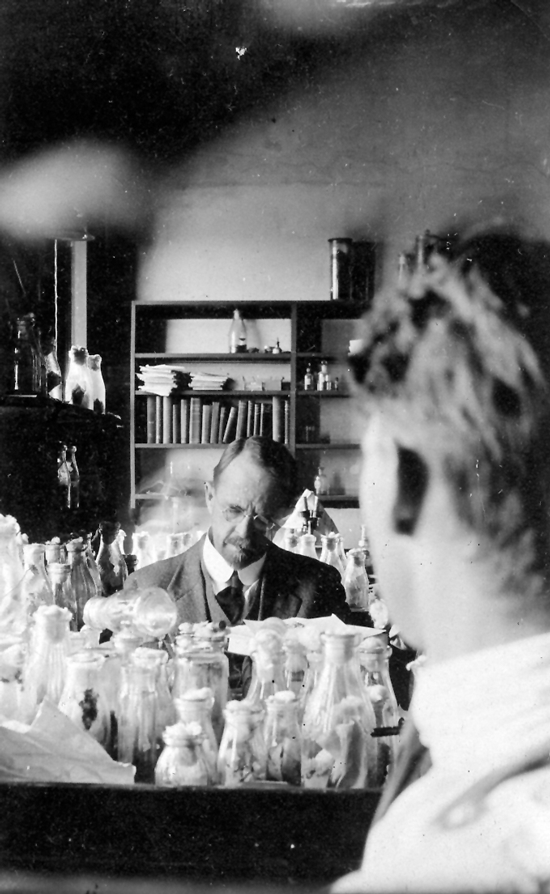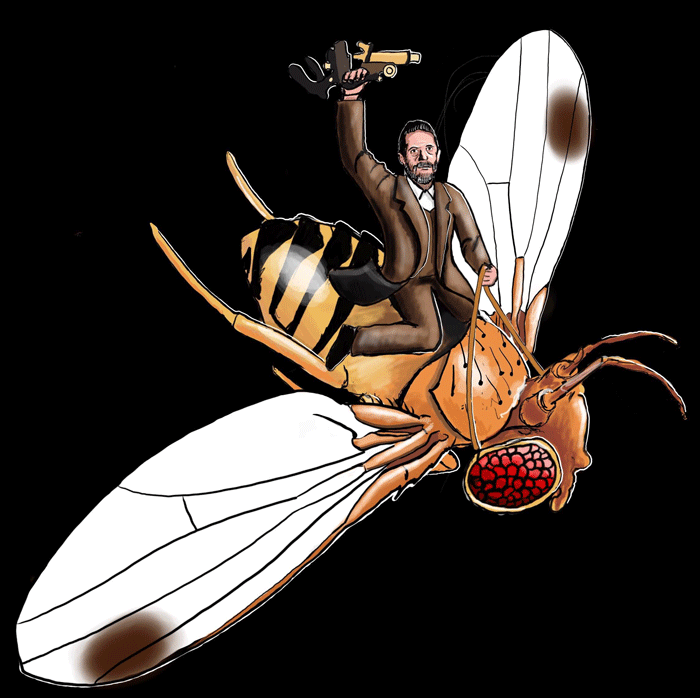In Kentucky 150 years ago today, a child was born who would—with the help of a hardy inhabitant of trash cans and fruit bowls— grow up to change the world.
That boy was Thomas Hunt Morgan. By the 1900s, the energetic young Morgan had become a well-respected expert investigating questions in experimental embryology and animal regeneration. But he is remembered today mainly for remarkable experiments in fruit flies that showed genes are carried on chromosomes, providing a tangible explanation for Mendel’s laws and establishing the first experimental system for mapping the units of heredity.
Drosophila melanogaster is a familiar pest found wherever there are piles of rotting fruit: orchards, vineyards, warehouses, kitchens, and dumps. But despite being easy to spot, it was not an obvious choice as the instrument of a genetics revolution. Drosophila are wild creatures; unlike the domesticated species favored by early geneticists—like Mendel’s round and wrinkled peas, or different colored “fancy” mice—fruit flies did not offer Morgan the luxury of visible trait variation. And there was no such thing as a pedigreed fruitfly. What drew Morgan to these humble insects?
Morgan was a wide-ranging thinker whose ideas came thick and fast, then had to be explored and tested quickly to make room for still more new ideas. “He wasn’t happy unless he had a lot of different irons in the fire at the same time,” remembered his student Alfred Sturtevant. Morgan worked with a huge variety of organisms and loved to try out new experimental systems and explore different species to find the most productive way to answer a particular question; sea spiders, brittle stars, frogs, chickens, pigeons, mice, fish, plants, and more.
In 1908 or so, Drosophila joined this endlessly rotating cast of experimental characters. Morgan had turned to fruit flies, (following the lead of W.E. Castle and C.M. Woodworth), in the hopes he could induce them to mutate. Some eight years earlier, Morgan had become interested in Hugo DeVries’ radical theory of evolution after a visit to the Dutch botanist’s garden to inspect some evening primroses. DeVries, who coined the term “mutation,” had planted wild seeds of Oenothera lamarckiana gathered from an abandoned potato field, which spontaneously produced a large variety of new forms that he called “mutants.” This prompted him to develop a theory that new species originated not from the slow and gradual selection of slight variations, as the proponents of natural selection argued, but in great phenotypic leaps during times of enhanced mutation rates.
Morgan held a variant of DeVries’ view, believing that such “mutating periods” existed, but rather than creating new species in single bounds, they produced additional variation with the normal range of a particular species. Morgan hoped to test this idea by inducing such a creative phase of evolution in a wild species that could be studied in the controlled environment of the lab.
That was why, argues historian Robert E. Kohler, Morgan chose Drosophila over a domesticated species, and why he forced his student Fernandus Payne to initiate his experimental stocks by luring wild flies with ripe bananas, rather than simply asking colleagues for their existing fly stocks. Morgan likely believed that existing inbred lab stocks would have already begun their mutating period. But the data took him in a radically different direction.
He and Payne threw a variety of insults at their flies to see if they could produce mutations. Drosophila were heated, cooled, centrifuged, irradiated, fed acids and bases, and plied with alcohol. Though an occasional mutant appeared, few were heritable, and the number was never statistically significant. According to Kohler, Morgan then considered the possibility that a mutation period could be induced by strong selection and inbreeding. For months he created inbred lines by selecting flies with the most extreme varieties of a trident-shaped body marking — essentially mimicking the process of intense natural selection.
Among the first mutants to emerge in his evolving stocks was a male with white eyes, rather than the usual rich red. When crossed with a red-eyed female, almost* all the offspring were wild type. But when these red-eyed progeny were crossed, white eyes reappeared exclusively in males.
Morgan knew that sex was specified by sex chromosomes; this had been established a few years earlier by his own student Nettie Stevens, and independently by his friend E.B. Wilson. Stevens had also shown that Drosophila females carried two X chromosomes, and males an X and a Y. Though he was skeptical of the Mendelians and the idea that chromosomes could carry specific genes, Morgan’s data eventually forced him to conclude that the white eyed mutation must be both recessive and located on the X chromosome. As the increased scale of his experiments turned up more and more mutants, and he immersed himself further in this new and overwhelmingly productive system, Morgan began to develop what remains our basic understanding of the mechanics of Mendelian heredity.
But this doesn’t answer the question of why Morgan picked Drosophila as his wild species of choice. Kohler has suggested fruit flies got their first foothold (pulvillus-hold?) in the laboratories of the early geneticists because they were well-suited to the classroom and for student projects:
“D. melanogaster’s natural history in orchards and cider mills, I have argued, matched the natural history of academic departments. Its seasonal demography matched the seasonal cycle of student projects and student labor; cheap and lowly, Drosophila was not shut out by the poverty of academic research funding.” —Kohler 1994
While Morgan was known to be personally generous, he was also legendarily miserly with grant money. And indeed, Morgan himself cited the lack of funds at Columbia University for “raising larger animals” as the reason he had turned to Drosophila. In those early years, the people Morgan encouraged to use the model tended to be either cash-strapped college teachers or others who could not contemplate more expensive and long-term projects: first-year grad students learning the ropes, technicians, women (who had limited career and funding prospects), a chronically-ill student, and undergraduates like Sturtevant and Calvin Bridges. The latter two would soon be transformed by their modest lab projects into rockstars of the field, and would quickly flesh out Morgan’s first insights into a detailed and incredibly productive theory of heredity.
“Just a few months after the white-eye discovery—Bridges and I got desks in his laboratory, the so-called “fly room” at Columbia, where the three of us worked together for the next 18 years. This was a room 16 × 23 feet in which there were eight desks. There was a place where we cooked fly food, and there were usually at least five people working in there. Bridges and I practically lived in this room; we slept and ate outside, but that was all. And we talked and talked and we argued, most of the time. I’ve often wondered since how any work at all got done with the amount of talking that went on, but things popped.” —Sturtevant 1967
From these cramped quarters, the first Drosophilists discovered mutants and mapped chromosomes and remade the fruit fly into a model organism that continues to provide answers to basic questions about how life works and evolves. By creating the experimental foundations of genetics, Morgan and his students and their flies created modern biology—and from that has come many of the advances that have dramatically changed how we live, eat, grow food, treat disease, and understand the natural world.
*See comment below by Paul K. Strode
This post was inspired by “Lords of the fly,” Kohler’s extremely readable history of the material culture and working customs of Morgan’s group.

Huettner, Alfred F. (Alfred Francis), b. 1884, “T.H. Morgan in the “Fly Room” Columbia University c. 1916″. History of the Marine Biological Laboratory. http://hpsrepository.asu.edu/handle/10776/2188
Citations:
Sturtevant, A. H. (2001). Reminiscences of TH Morgan. Genetics, 159(1), 1-5.
http://www.genetics.org/content/159/1/1
(Note for the confused: Sturtevant was speaking in 1967, but the account of his speech was published in 2001)
Kohler, R. E. (1994). Lords of the fly: Drosophila genetics and the experimental life. University of Chicago Press.
http://www.press.uchicago.edu/ucp/books/book/chicago/L/bo3617623.html













